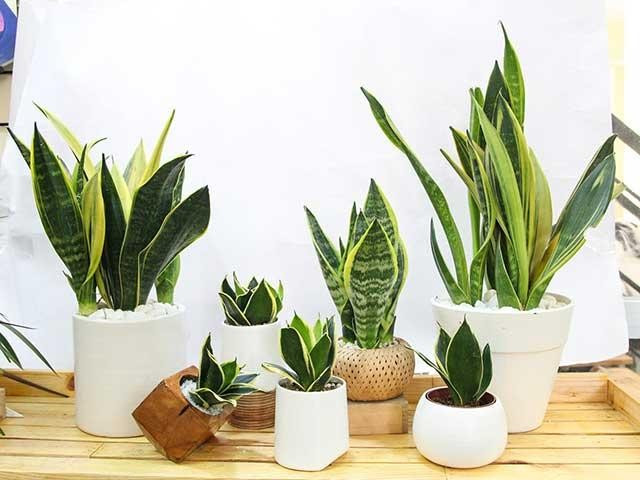Indoor green plants bring many benefits. They help purify the air, freshen up the space, and even reduce stress and fatigue for humans.
However, not all types of plants are suitable for families with pets, and some plants contain harmful substances that are dangerous to them.
Spruce has compiled a list of popular indoor plants that are not pet-friendly for homeowners to consider when planting:
1. Devil’s Ivy

Devil’s Ivy is a small-leaved plant that can be planted in soil or hydroponically. This type of plant is easy to grow indoors and often grows beautifully cascading down to the ground. However, pet owners should be cautious when growing Devil’s Ivy.
All parts of Devil’s Ivy, such as the roots and leaves, can be dangerous to pets. Common symptoms of poisoning include diarrhea, vomiting, and even liver failure.
Other names: Pothos.
2. Sago Palm

The Sago Palm is one of the plants that is considered very dangerous for dogs and cats. The toxic substance cycasin in this plant causes symptoms such as vomiting, blood clotting disorders, and liver damage in pets.
If you have Sago Palm plants indoors, it is recommended to keep them out of reach of pets. Veterinarians even advise against planting this plant indoors if you have dogs or cats.
Other name: Coontie Palm.
3. Aloe Vera

The Aloe Vera plant is commonly grown indoors due to its various uses such as beauty, treating minor burns, and wound healing. This plant has many beneficial uses for humans, but it can be harmful to pets if they accidentally ingest it. Eating Aloe Vera leaves can cause pets to experience digestive issues, even fainting.
Other names: Aloe, Aloe Vera.
4. Swiss Cheese Plant

The Swiss Cheese Plant, or Monstera Deliciosa, is a tropical plant often grown indoors for decoration. They have beautiful, attractive leaves, but you should carefully consider before planting them if you have pets. The toxins in Swiss Cheese Plants can cause dogs and cats to experience pain, swelling of the mouth, tongue, lips, excessive drooling, and vomiting.
Other names: Split-leaf Philodendron, Monstera Deliciosa.
5. Jade Plant

The Jade Plant, also known as Jade Tree or Money Plant, is a type of succulent plant. It has thick, green leaves and is considered a beautiful plant. However, pet owners should be extremely cautious with this plant.
If pets accidentally ingest parts of the Jade Plant, they can experience serious reactions such as stomach pain, abnormal heart rate, and respiratory damage.
Other names: Jade Tree, Money Plant.
6. Snake Plant

The Snake Plant, also known as Mother-in-Law’s Tongue or Viper’s Bowstring Hemp, is a popular indoor plant. This plant can survive in harsh conditions and has the ability to improve air quality.
Snake Plants are safe for humans, but they can be dangerous to dogs and cats. If pets accidentally ingest Snake Plant leaves, they may experience nausea and diarrhea.
Other names: Mother-in-Law’s Tongue, Viper’s Bowstring Hemp.
7. English Ivy

English Ivy, also known as Common Ivy or European Ivy, is a climbing plant that is commonly used as a decorative plant indoors.
This plant often grows long branches that cascade down to the ground, making it enticing to dogs and cats. It can be very dangerous if pets eat the leaves of the English Ivy. The toxins in the leaves can cause pets to experience vomiting, abdominal pain, and diarrhea.
Other names: Grape Ivy, English Ivy.
8. Dieffenbachia

Dieffenbachia, also known as Dumb Cane, is a commonly grown indoor plant. This plant can withstand harsh conditions and has the ability to improve air quality.
Dumb Cane is safe for humans but can be dangerous to dogs and cats. If they accidentally swallow parts of the plant, pets may experience nausea and diarrhea.
Other names: Dumb Cane, Dieffenbachia.
9. Peace Lily

The Peace Lily is one of the most popular indoor plants. This plant has dark leaves and white flowers, making it highly favored. Consequently, many people choose to display Peace Lilies indoors and outdoors.
However, Peace Lilies contain a toxic substance called calcium oxalate. If dogs or cats eat the plant, this toxin can cause pain and swelling in their mouth, and even lead to vomiting.
Other names: Spathiphyllum, Peace Lily.
Source: Education & Era/Spruce

Couple Builds 3-Storey Bamboo House on an Island, Cool Year-Round




































